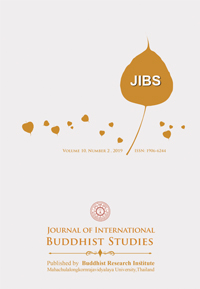Sukhothai Kingdom: The Golden Age of Buddhism
Abstract
This article entitled “Sukhothai Kingdom: The Golden Age of Buddhism.” It is called so due to the absorption of Buddhist conceptions, all Sukhothai kings were righteous rulers. The title of the kings which at one time used to be the “Lord of war” changed into the “Lord of Dhamma.” Sukhothai’s administrative regime was based on the “Father-Son” relationship. Kings were respected as the fathers to all the people, which implies that they adhered to the code of morality and protected people like their own children. People during this period believed in the principle of Kamma which is relevant to Buddhism. Thus, the Sukhothai period is regarded as the “Golden Age of Buddhism” in the history of Thailand.The arrival of Buddhism in Thailand can be supported by the archaeological evidence and literary accounts as well as other geographical and historical records and traditional beliefs, which tend to suggest that this religion was introduced into Thailand at four different phases as detailed: i) Early Theravada Buddhism in the 3rd century B.C. ii) Mahayana Buddhism in the 7th century A.D. (Northern sect) iii) Pukam or Pakan Theravada Buddhism in the 11th century A.D. iv) Lankavamsa or Lankavong Theravada Buddhism in the 13th century A.D.During the fourth phase of the introduction of Buddhism into Thailand where at that time was called Sukhothai, which was recognized as the first kingdom of Thailand. It was in this period that Ramkhamhaeng the great king of Sukhothai sent messengers to invite the group of monks at the town of Nakhon Si Thammarat then known as the “Lankavamsa” monks to preach the doctrine at Sukhothai, promoting them every help and convenience. Since then Lankavamsa or Lankavong Theravada Buddhism was well patronized by king Ramkhamhaeng, it finally superseded the existing previous beliefs.
References
Mahamakut Buddhist University.(1974). Buddhism in the Kingdom of Thailand. Bangkok: Mahamakuta Rajavidyalaya Press.
Griswold, A.B. and Prasert.(1975). Na Nagara, Kingship and society at Sukhothai, in Change and Persistence in Thai Society, (ed. by Skin- ner and Kirsch). Ithaca: Cornell University Press.
Gosling, Betty.(1989). Sukhothai: Its History, Culture and Art. Asia Books: Oxford University Press.
Kr. Singh, Nagendra.(1996). International Encyclopedia of Buddhism, vols. 62 & 63, New Delhi: Anmol Publications Pvt. Ltd.
Kromamun Bidyalabh,H.H. Prince Dhani Nivat.(1965). A History of Bud- dhism in Siam. Bangkok: The Siam Society.
Majumdar, R.C. & Raychaudhuri, H.C.(1953). An Advanced History of India. London.
Pisanaka, Kraingsak.(1969). Thai Ha Yuk. Bangkok: National Library. Phra Dhammapitaka (P.A. Payutto).(1984). Thai Buddhism in the Bud-
dhist Word. Bangkok: Sahadhamika Co., LTD.
Phramaha Payut Payutto.(1972). Education of the Thai Sangha, Buddha
Cakra: Special Volume.
Rajanubhav, Prince Dhamrong.(1946). History of Sukhothai Dynasty.
Bangkok:Aksornborikan Press.
Rajanubhab, H.R.H. Prince Damrong, Vice – Patron of the Siam Society
(1905-1943): A History of Buddhist Monuments in Siam. translated by S.Sivaraksa.(1962). Bangkok: The Siam Society under Royal Pa- tronage.
Suksamran, Somboon.(1982). Buddhism and Politics in Thailand, A Studyof Socio-Political Change and Political Activism of the Thai Sangha.
Institute of Southeast Asian Studies: Singapore.
Sukhothai: The Dawn of Happiness.(2002). Bangkok: Department of Cur-
riculum and Instruction Development, Ministry of Education. National Identity Board.(1995).Thailand in the 90. Bangkok: Office of the
prime Minister.
____.(1995).Thailand into the 2000’s. Bangkok: Office of the prime Min-
ister, 1995.
Wyatt, David K.(2003). Studies in Thai History. Silkworm Books, Cornell
University.
Website
http://www.mahidol.ac.th/Thailand/glance-thai/area.html. Visited on May 26,
http://www.thaizer.com/royal-family/king-ramkhamhaeng-the-great, vis-
ited on January 21, 2016.







